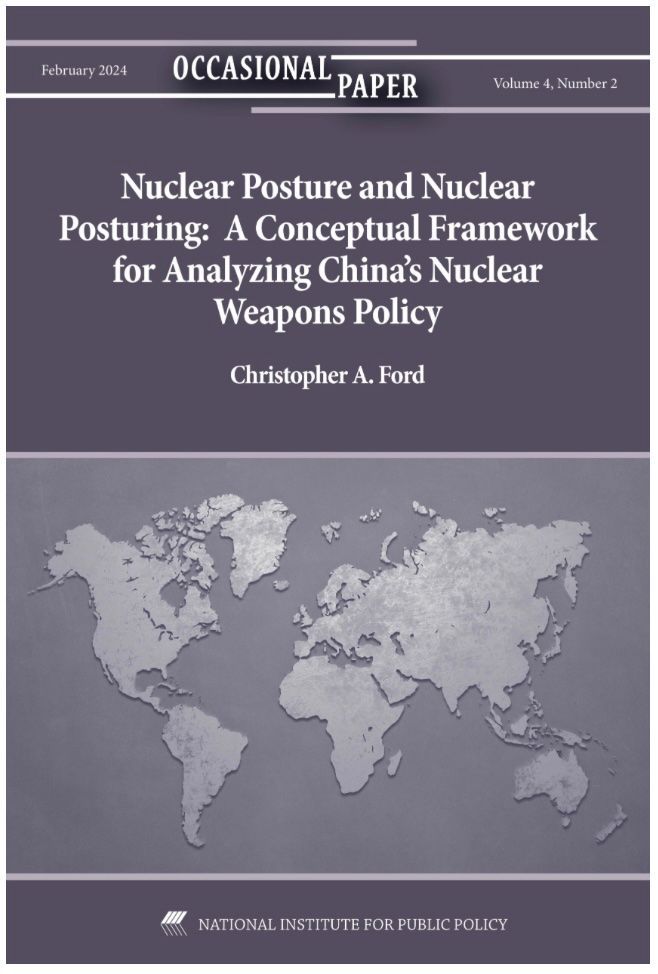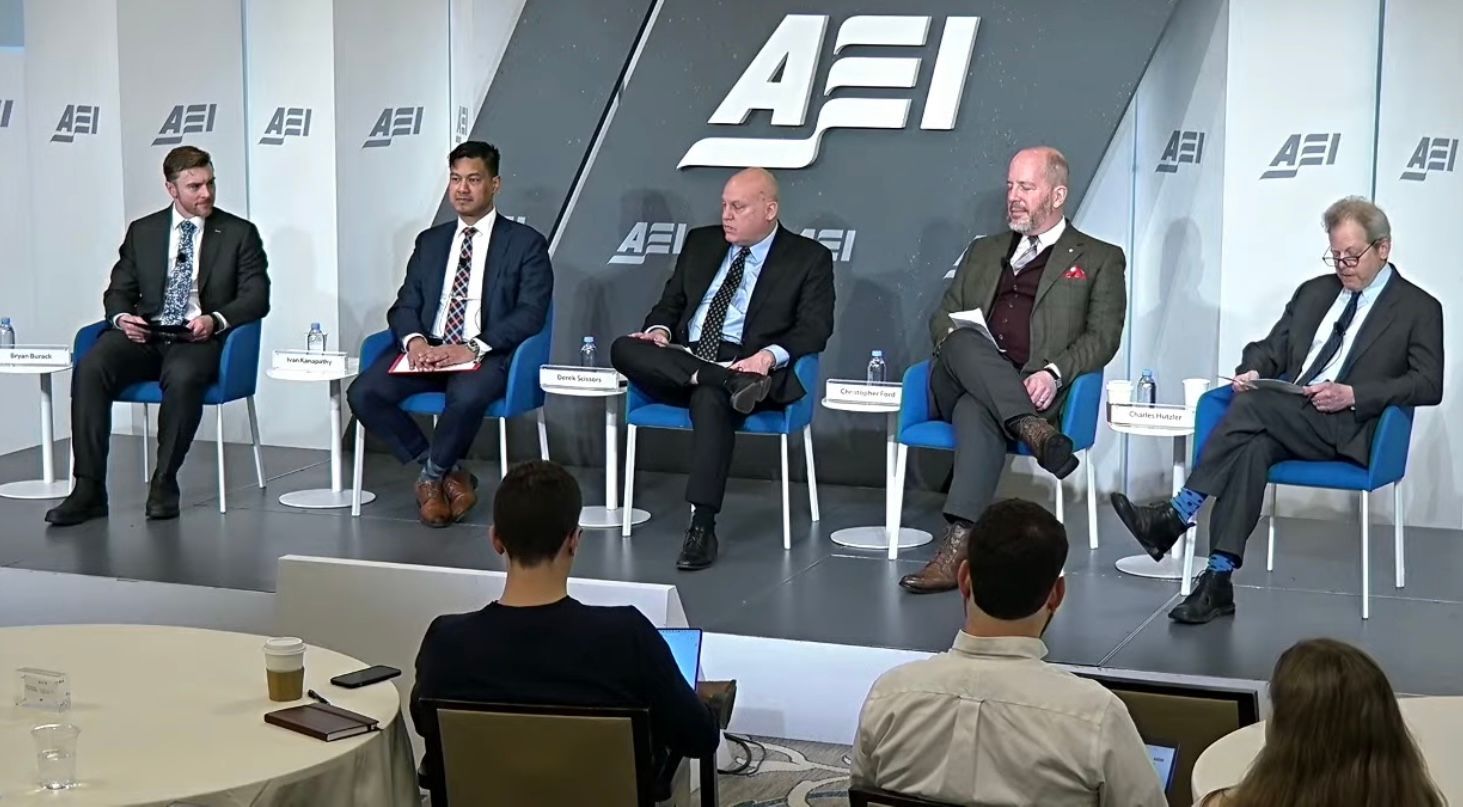The Hon. Christopher A. Ford
New Paradigms Forum -- International Security Policy Since 2009
Competitive Strategy vis-a-vis China: The Case Study of Civil-Nuclear Cooperation
Note:
Below are remarks that Assistant Secretary Ford delivered to the Project 2049 Institute in Arlington, Virginia, on June 24, 2019. They can also be found here , on the website of the U.S. State Department's Bureau of International Security and Nonproliferation.
Good evening, and thank you for inviting me to speak at this dinner. I’ve done a lot of speaking over the last year or so about how we in the U.S. Government are reorienting our approaches to China policy, building a competitive strategy vis-à-vis Beijing pursuant to guidance in the 2017 National Security Strategy (NSS) and the 2018 National Defense Strategy (NDS), which made clear the need for new approaches to great power competition with China and Russia – that is, to the “[i]nter-state strategic competition” that the National Defense Strategy makes clear “is now the primary concern in U.S. national security.”
But we haven’t just been doing all this security policy recalibration in response to the NSS and the NDS. In fact, these readjustments in U.S. national security and foreign policy have been some time coming, and are grounded in an evolving appreciation of China’s behavior, improved understandings of its strategic ambitions and objectives, and a keen awareness of the risks that both of these factors present to U.S. interests and to those of international peace and security.
The principal driver in these U.S. policies has thus been China, which is increasingly forcing the rest of the world to confront difficult questions of this sort. While it is certainly unfortunate that we face an increasingly challenging relationship with China today, we are focused on addressing those challenges now.
To help illustrate these points, I’d like to tell you a story, giving you, as it were, a case study of competitive strategy development with China from my perspective at the State Department. We do many things in our little corner of the Department, known as the Bureau of International Security and Nonproliferation, but my story this evening principally concerns only two of them: our role in negotiating civil-nuclear cooperation agreements (a.k.a. “123 Agreements”) and our role in national security export control policy involving China. The interplay of these roles shows one very specific way in which, as it were, America’s China policy has changed as a result of our improving understanding of China’s America policy.
I. Painful Lessons
The United States has had a 123 Agreement in place with China since 1985. That first agreement expired, and was superseded in 2015 by a new one negotiated by the Obama Administration, which proclaimed that the deal – and the export licensing policies that were thus set in place – would advance U.S. national security interests, particularly in nonproliferation policy. Unfortunately, that didn’t turn out to be true.
That said, my story also ends with the United States’ development of new policies in light of these problems in order to respond to Chinese security-related challenges in this arena. And my story concludes with a request for help from you – help, that is, in spreading awareness and encouraging others to learn from the serious challenges we have faced with China’s nuclear industry and to adopt similarly cautious and prudent postures of their own.
The fundamental problems with engagements with the Chinese nuclear industry, to which our policy is now reacting, are fivefold.
First, at the most structural level, Beijing uses its large, rapidly-growing, state-sponsored nuclear industry as a strategic tool with which to augment China’s “comprehensive national power” – both through development in the civilian sector and in support of a military buildup.
Second, precisely because it is in large part a strategic rather than a purely economic tool, the Chinese nuclear industry operates on strategic rather than economic principles. That is, it makes decisions not so much on the basis of economic, financial, or technological rationality but rather in order to make China more powerful in geopolitical terms and to entangle foreign partners in asymmetric relationships of debt and dependency that can be manipulated for political and strategic ends.
Third, the role of the Chinese nuclear industry as a strategic tool – coupled with the CCP’s emphasis upon growth and expansion at virtually any cost – has led to growing concerns about the safety of Chinese reactor designs, construction projects, and civil nuclear operations. Quite simply, Chinese officials have favored domestic and foreign expansion of the nuclear sector over safety and reliability, and because of the speed of growth, Chinese regulators have not been able to keep up.
Fourth, the growth and success of the Chinese nuclear industry has been based, in considerable part, upon the systematic acquisition of foreign nuclear technology, both licit trade and through systematic theft. China systematically targets a variety of foreign technology areas, including through cyber-facilitated and other forms of theft, and the nuclear sector is one of Beijing’s major priorities.
Fifth and finally, the Chinese nuclear industry is not a purely civilian industry, instead operating in close partnership with the People’s Liberation Army (PLA) and in support of Beijing’s efforts to fulfill the so-called “Strong Military Dream” of high-technology military modernization. To cooperate with the Chinese nuclear business, in other words, is thus to some extent inescapably to cooperate with the PLA. The nuclear industry’s promotional relationship with Beijing’s security interests and strategic objectives, moreover, has helped give it a very worrying, far-too-close-for-comfort relationship with the Chinese security services, even in its overseas operations.
To my eye, all of these factors compel the conclusion that it would be little short of madness for any potential foreign partner to engage uncritically with the Chinese nuclear industry. That’s not to say that one should necessarily entirely shun them – and indeed the new U.S. nuclear export control policy we announced last year does not prohibit U.S. nuclear companies from all dealings with China.
What is clear, however, is that any engagement with the Chinese nuclear industry must be informed by a full understanding of its nature, its activities, and its relationship to Beijing’s military assertiveness and the Chinese Communist Party’s authoritarian project. For us, that has meant dramatically scaling back the scope of permissible U.S. engagements by imposing major new export licensing restrictions.
Nevertheless, we Americans are in a more fortunate position than some. While the Chinese nuclear industry seeks engagements with the U.S. civil nuclear sector, we are unlikely to enter into the kind of 50- or even 100-year relationship that can be entailed by a major reactor project. For the most part, we – and others whose intellectual property Chinese technologists covet – simply need to stop foolishly supplying them with the tools they seek to do us ill. For some other countries, however, taking a properly prudent approach to the Chinese nuclear industry may require shunning involvement with such Chinese projects altogether. As we have discovered to our own dismay over the last few years, after all, it turns out to be far more difficult than expected to mitigate the risks in this area.
So let’s unpack my list of factors, and the hard lessons we have learned about them.
II. A Perfect Storm of Problems
A. The Nuclear Industry as a Strategic Tool
Much as it aspires to do in a range of high-technology manufacturing sectors under its so-called “Made in China 2025” policy, Beijing seeks to use its civil nuclear industry to crush other competitors’ nuclear power industries and develop next-generation reactors and technologies, and dominate the global market. As with “Made in 2025,” moreover, China’s methods in the civil nuclear arena involve using government subsidies, mobilizing state-owned enterprises along strategic lines of effort dictated by the CCP leadership, and acquiring foreign technology and intellectual property – through lawful means, forced transfers, and simple theft alike – in order to ensure Chinese dominance.
In support of its broader strategic aim of claiming for itself the position of global power and status it feels itself to have been unfairly denied for many years, China is using civil nuclear cooperation to increase its influence across South and Central Asia, the Middle East, Europe, and South America, seeking to increase its coercive influence over weaker states through the many-decades-long relationships that are created by civil nuclear projects. In less developed countries with authoritarian systems or smaller democratic institutions, and in countries with financial and economic instability, nuclear cooperation gives China leverage and may support Beijing’s effort to promote the Chinese model of modernization, which relies upon authoritarian politics and state-managed economic activity, and which rejects the established norms that have underpinned global order since the end of World War II.
In advanced industrial economies, inroads by the Chinese nuclear industry present somewhat less danger of entrapment into politically-coercive “neo-neocolonial” relationships, though they can still be potent sources of pressure and manipulation. Nonetheless, even involvement in advanced economies serves Beijing’s strategic purposes because of the opportunities it offers for stealing technology – as well as for “branding” China’s arrival as a high-status global power in ways that help the CCP claim legitimacy, and help Beijing leverage each such engagement into further engagements and opportunities.
B. Predatory Economics
In support of its strategy, China uses a multi-faceted, whole-of-system approach to exploit and reverse engineer both legally- and illicitly-acquired foreign nuclear technologies, in order to advance its own “indigenous” nuclear technologies, and in at least one instance, to sell Chinese versions of foreign designs – as it did with a Canadian reactor some years ago after stealing information about its design parameters. (In time, China aims to move to fully indigenous designs, but much of its advances to date have come only with the help of foreign technology, including stolen technology.) China has stated that its goal is to capture at least 35 percent of the global civil nuclear market in the next 20 years, targeting specifically the so-called “belt and road” countries as a starting point.
China sometimes uses economic coercion to pressure countries into cooperation on civil nuclear reactor projects. In particular, China is targeting Western Europe, seeking successive footholds there in order to claim a reputation as a reliable supplier of technology. To do this, China is willing to utilize its economic and trade leverage to pressure governments into committing to cooperation whether or not those governments are really ready to do so.
As an example, when the British government announced in 2016 that it was reevaluating a proposed French-Chinese civil nuclear construction project at Hinkley Point, the Chinese Ambassador to the UK published an op-ed threatening the entire China-UK bilateral relationship – across all economic sectors – should London not move forward with the nuclear reactor project. This threat, of course, played on British economic anxieties associated with BREXIT in order to prod the UK to let the Chinese nuclear industry gain footholds in Britain.
China, in a sense, expects a return on all its investments. Since Beijing does not approach such issues purely from an economic perspective, however, the return it expects can be often be political. In this context, Chinese ownership and operational relationships with foreign infrastructure projects represent potential political pressure and influence points. For example, Greece joined other countries in blocking European Union criticism of China’s human rights abuses after China’s COSCO Shipping acquired a 51 percent share in Greece’s most important port.[1] One should expect that, however enticing China’s easy-money nuclear financing may look, foreign entanglement with that Chinese industry will have its political costs too.
C. Safety
The fundamentally strategic nature of Chinese civil nuclear decision-making is perhaps also why Beijing has been willing to support the industry’s expansion well beyond what Chinese regulators have been able to handle, with potentially grave consequences for reactor and operational safety at Chinese nuclear plants. The CCP’s priority in dealing with the nuclear industry has been to ensure rapid domestic expansion, coupled with foreign expansion in support of geopolitical objectives. Safety and the quality and integrity of regulatory oversight, however, has not been similarly prioritized or resourced, leaving the Chinese regulatory apparatus more in the position of providing construction management services than safety oversight – much, it has been described to me, like U.S. regulators approached things before the Three Mile Island nuclear accident in 1979.
China’s huge nuclear state-owned enterprises (SOEs) want as much Western technology as quickly as they can, but they aren’t always willing to work with the actual developers and producers of such technology in the ways they should in order to ensure proper safety and quality control. Instead, in order to expedite incorporation and localization, these SOEs sometimes choose to save time and money by hiring outside experts who aren’t necessarily intimately familiar with the technology. All three SOEs – China National Nuclear Corporation (CNNC), China General Nuclear Power Corporation (CGNPC), and the State Power Investment Corporation (SPIC) – have willfully cut corners in design, testing, and safety protocols in order to save money and achieve research and development (R&D) goals more quickly. Seeing faster timelines and faster construction as their tickets to international competitiveness and domestic self-sufficiency, they may have deliberately sacrificed safety on the altar of such expansion.
In order to save money, China’s nuclear SOEs have sometimes circumvented cooperation with international companies that would have been needed in order to comply with licensing requirements and meet the most rigorous and stringent Western “best practice” safety standards. In one documented instance, for example, the CNNC subsidiary Nuclear Power Institute of China (NPIC) rejected a recommended training program that would have helped qualify the Hualong-1 reactor design. Despite willfully foregoing this safer course of action, CNNC continues to market the Hualong-1 to countries such as Pakistan and Argentina. Prospective customers, however, should bear in mind the degree to which they may be being used as guinea pigs for not-fully-tested designs as China scrambles shore up its international nuclear bona fides by finding showcase projects in such markets. This is yet another reason to be wary when it comes to inviting the Chinese nuclear industry to set up camp in your homeland.
D. Theft
And of course there is the problem of just how China gets some of the nuclear technology it markets. All three of China’s nuclear SOEs have engaged in illicit activities against their international competitors – and even their international partners – including theft, unauthorized reverse engineering, and aggressive recruitment of international subject matter experts.
The most obvious example of this is the China General Nuclear Power Corporation, which was indicted in April 2016 – along with an employee named Szuhsiung “Allen” Ho – for conspiracy to steal U.S. nuclear technology for use in Chinese reactor designs. To this end, Ho and CGNPC recruited many international experts to illicitly provide proprietary information and critical know-how. Ho eventually pleaded guilty and served time in prison. CGNPC, however, has not responded to the U.S. indictment and continues to market its nuclear wares abroad – even to the point that it is presently between a one-fifth to two-thirds partner in three major British nuclear reactor projects. What could possibly go wrong?
E. Security Implications
On top of all this, China’s nuclear industry is also a vehicle for advancing China’s military modernization programs through the diversion and adaptation of foreign civil nuclear technology to military and dual-use nuclear programs in the land, maritime, aerospace and outer space domains. Under the policy of “military-civil fusion” (MCF) – a top-priority national effort overseen by Xi Jinping himself – China is has put in place laws and policies that facilitate military diversion and exploitation of any technology accessible to anyone within China’s jurisdiction.
This is no less true in the civil nuclear arena than in any other, and Beijing systematically seeks to exploit international-origin nuclear technologies and expertise for military programs. Civil nuclear technology, in fact, is specified as a key target sector under MCF – a strategy that explicitly seeks to prepare China for success as the first country to succeed in harnessing the “revolution in military affairs” that Chinese strategists feel will help decide who gets to dominate geopolitics later in this century.
All this, of course, raises sobering questions for anyone contemplating civil nuclear cooperation with China. Such cooperation depends upon the integrity of end-use assurances, licensing conditionality, “deemed export” controls, and other mechanisms designed to prevent the diversion of materials or technology to unapproved purposes, and especially to non-peaceful ones. Yet MCF – coupled with China’s laws on technology transfer and cooperation with the security bureaucracy, and with recurring efforts to conceal the actual institutional background of many Chinese researchers doing advanced R&D work in Western countries – deliberately undermine this system of assurances.
MCF seeks to acquire technology for military programs, to recruit foreign talent to undertake R&D in China, and to utilize universities, SOEs, and the intelligence apparatus to push this strategy. The foreign nuclear industry is a central focus of MCF, with MCF’s efforts particularly focused upon nuclear technology for naval propulsion programs – specifically, for Chinese submarines, unmanned underwater vehicles, floating power plants, aircraft carriers, and icebreakers. The development of such naval propulsion options supports Chinese Navy plans to build a global military presence, as well as to enhance its global footprint more broadly with nuclear-powered icebreakers to assert China’s presence in the Arctic.
At present, China’s naval nuclear reactor programs have a long way to go before they can effectively support these ambitions for a global naval presence. China’s naval nuclear reactors for their currently- deployed nuclear submarines are decades behind NATO technology, and the Chinese military reactor program’s personnel, designs, technologies, industrial base, and manufacturing techniques almost certainly still fall short of their full potential. We think China will face significant design, construction, and quality assurance hurdles as it attempts to achieve key milestones such as: improving its reactors from the current currently-deployed attack submarines (SSNs) and ballistic missile submarines (SSBNs); developing reactors for its next-generation SSNs, SSBNs, and aircraft carriers; and developing small modular reactors (SMRs), including offshore and maritime SMRs to serve as floating nuclear power plants (FNPPs) to provide power for manufactured islands in the South China Sea.
This makes areas such as SMR technology key targets for MCF-based technology acquisition efforts, and nearly any engagement with Chinese industry in these areas could be turned into a means to advance China’s military reactor programs. Ostensibly civilian research institutions, for example – including the China Academy of Sciences Institute of Nuclear Energy Safety Technologies – receive military funding for next-generation nuclear reactor R&D, and more than 80 Chinese universities are now certified to undertake military R&D. Practices of systematic “background obfuscation,” moreover, help make it difficult for outsiders to tell which Chinese researchers are “purely” civilians and which ones are being sent abroad, including by the PLA itself, to undertake advanced research and R&D in support of MCF objectives.
Already, China’s military is using other countries’ civil nuclear software to research and design new-generation SMRs, offshore SMRs, micro-reactors, and Generation IV reactors for military end-uses. And do you remember CGNPC, the company under U.S. indictment for technology theft? It is working on offshore SMRs for FNPPs with the China Shipbuilding Industry Corporation (CSIC). CSIC adheres to MCF, supports China’s naval submarine and aircraft carrier reactor programs, and is illicitly repurposing Western nuclear software codes for such uses. Published research from key entities in China’s maritime nuclear power program – including CSIC, CNNC, Harbin Engineering University, and the PLA Naval Engineering University – demonstrates their use of U.S. and other Western technology for maritime reactors.
Perhaps not surprisingly – given the importance of the nuclear sector in China’s MCF strategy, and Xi Jinping’s 2016 declaration that it is the job of China’s SOEs to support the enhancement of overall national power – all Chinese nuclear entities are legally mandated to support China’s security services. Indeed, China’s 2017 National Intelligence Law requires all citizens and organizations to support, assist, and cooperate with national intelligence efforts. And China’s nuclear industry does receive direct support from China’s civilian and military intelligence services, including from cyber espionage.
In 2014, for instance, PLA hackers were indicted for breaking into systems of the Westinghouse Electric Corporation, from which they stole confidential business strategies regarding negotiations with a Chinese SOE on future plant construction. They also stole confidential proprietary information in the form of technical and design specifications for Westinghouse’s AP1000 reactor design, to enable China to build a similar power plant without major R&D costs.
Using more traditional collection methods, the Chinese have also stolen Canadian reactor designs by organizing a supposed Chinese friendship and cultural organization to cultivate contacts among Canadian laboratories and facilities.
III. Our Responses
So this is the backstory – which I have illustrated for you this evening with some specific details and case studies of how we came to realize that we had been far too trusting in our approach to civil nuclear cooperation with China under the 123 Agreement of 2015. It was principally on the basis of the facts I have outlined here that the United States revised its policy on permitting civil nuclear exports to China in October 2018, modifying the rules for the Department of Energy licensing under 10 C.F.R. Part 810, as well as a number of broader export license policy changes. It was also in light of these facts that we at the State Department have begun exploring how we can use our diplomatic skills more strategically ourselves, such as by employing a new approach to Nuclear Cooperation Memoranda of Understanding (NCMOUs) in support of efforts by the U.S. nuclear industry to build cooperative relationships with overseas partners. (The first such NCMOU we negotiated was signed with Poland on June 19.)
All of this is an evolving story, of course, so I cannot point you to a climactic “ending.” But it is, I hope, an illuminating tale, not least because it has implications well beyond the sphere of export controls and export licenses for civil nuclear cooperation. This story is just one case study of a broader phenomenon – namely, that under this Administration, the U.S. Government is finally coming to recognize and act to respond to the challenges presented by China’s increasingly assertive international self-aggrandizement and the sweep of its global ambitions.
And so, to conclude, I return to the request I told you I would make for help. If our partners and allies are to respond effectively to such challenges we must all work to spread awareness of these problems and to encourage others around the world to take from the lessons we ourselves have had to learn. I have offered our experiences with China’s nuclear industry as a cautionary tale, because we got too many things wrong for too long. But I also offer the story as a sign of what success can begin to look like, and as a model for how others should re-assess these threats and act to meet them.
So I urge you to work with us to spread word of these problems and to encourage thoughtful and resolute responses. We need more of them, not just here in the United States, but from all of China’s would-be nuclear partners around the world.
Thank you.
-- Christopher Ford
[1] Robin Emmott and Angeliki Koutantou, “Greece blocks EU statement on China human rights at UN,” Reuters, June 18, 2017.



Copyright Dr. Christopher Ford All Rights Reserved






